Retail Transformation under the Influence of Digitalisation and Technology Development in the Context of Globalisation
Abstract
1. Introduction
Literature Review
2. Methods
2.1. KOF Index of Globalization (KOFGI)
2.2. Global Retail Development Index (GRDI)
2.3. Top 50 Global Retailers’ Presence Index (ITOP-50)
2.4. Correlation Analysis
3. Calculations and Interpretation of Results
- The values of some KOF subindices of globalisation used in calculations of KOFGI are gradually approaching their limits and, accordingly, their globalisation potential and effect on the overall globalisation process is diminishing. Specifically, information globalisation has run a very fast course over the past decade and the KOFInGI subindex reached 74.6. Information globalisation affected other constituents of overall globalisation. This is underscored by the clear direct correlation between the KOFInGI subindex, on the one hand, and the KOFEcGI, KOFTrGI, KOFSoGI, and KOFCuGI subindices, on the other: R2KOFGI/KOFInGI = 0.986; R2 KOFEcGI/KOFInGI = 0.937; R2 KOFTrGI/KOFInGI = 0.959; R2 KOFSoGI/KOFInGI = 0.999; R2 KOFCuGI/KOFInGI = 0.987. With that, the strongest correlation is observed between information globalisation and the processes of social and cultural globalisation. Accordingly, one can assume that information globalisation appeared as a major contributing driver in the development of the modern sociocultural environment and buying and consumption behaviours and can serve as a guide for the direction of transformation in the distribution sector.
- Apart from objective factors, the slowdown in globalisation in the past years reflected the intent of some developed countries, specifically, the USA, to deter economic growth in developing countries by limiting their advance in the global economic space. This slowdown in globalisation and sometimes de-globalisation trends are obvious in the dynamics of the KOFEcGI and KOFTrGI subindices. The crisis of 2008 led to a weakening of economic and trade ties between countries. It caused not only a slowdown of overall globalisation but also some de-globalisation in certain areas. e.g., the KOFEcGI and KOFTrGI subindices showed a decline as of 2009: after one year of crisis, KOFEcGI fell to 57.9 in 2009 from 58.5 in 2008 and KOFTrGI declined to 57.0 from 58.6. We believe the slowdown in globalisation between 2015 and the present time results from the policy of developed countries to deter economic growth in developing countries.
- Cultural globalisation has not only slowed down compared to other constituents of overall globalisation but also demonstrated a decline over recent years: KOFCuGI declined to 54.5 in 2016 from 54.8 in 2013.
4. Discussion
4.1. Retail Transformation, Digitalisation, Technology Development, and Globalisation
4.2. Open Innovation with Retail Transformation by Digitalisation
- -
- an innovation process directed from the outside into the company;
- -
- an innovative process aimed at the external environment;
- -
- combined innovation process; knowledge and innovation move in both directions.
4.3. Cooperative Value Creation, Sharing Economy
5. Conclusions
Author Contributions
Funding
Data Availability Statement
Conflicts of Interest
Appendix A
| Indicators | Sources |
|---|---|
| 1. Average per capita disposable household resources in the Russian Federation | https://rosstat.gov.ru/folder/13397 |
| 2. Share of population with average money income below the threshold set based on the actual money income levels (per capita, median and modal) | https://rosstat.gov.ru/free_doc/new_site/population/bednost/tabl/tab-bed2-7.htm |
| 3. Employment in the Russian Federation in the age bracket between 15 and 72 | https://rosstat.gov.ru/labour_force |
| 4. Unemployment in the age bracket between 15 and 72 | https://rosstat.gov.ru/labour_force |
| 5. Labour productivity indices in the Russian economy | https://rosstat.gov.ru/folder/11186; |
| 6. Increase in high productivity jobs in the Russian Federation | https://rosstat.gov.ru/folder/11186; |
| 7. Share of population using the Internet to order goods and (or) services as a percentage of the total population, % | https://rosstat.gov.ru/folder/14478 |
| 8. Environmental spending in the Russian Federation | https://rosstat.gov.ru/folder/11194 |
| 9. Outbound tourism, thousands | https://rosstat.gov.ru/folder/23457 |
| 10. Migration activity | https://rosstat.gov.ru/folder/12781 |
| 11. Per capita volume of paid cultural services | https://rosstat.gov.ru/bgd/regl/b19_78/main.htm |
| 12. Per capita volume of paid healthcare services | https://rosstat.gov.ru/bgd/regl/b19_78/main.htm |
| 13. Volume of tourism services, million rubles | https://rosstat.gov.ru/folder/23457; |
| 14. Share of products compliant with quality and safety standards | https://rosstat.gov.ru/folder/23457; http://zpp.rospotrebnadzor.ru/badproducts/results; |
| 15. Relative weight of retail chains in the retail turnover of food products | https://rosstat.gov.ru/folder/210/document/13233. |
References
- Timchenko, E.V.; Klimonova, A.N. Globalizatsiya kak zakonomernaya tendentsiya evolyutsionnogo razvitiya obshchestva [Globalisation as a logical trend of social evolution]. Sotsialno-Ekon. Yavleniya Protsessy 2015, 10, 74–77. [Google Scholar]
- Nazarov, R.N. Sotsialno-metodologicheskii analiz sushchnosti globalizatsii [Socio-methodological analysis of the essence of globalisation]. Vestn. Tadzhikskogo Tekhnicheskogo Univ. 2009, 4, 88–92. [Google Scholar]
- Ryzhenenkov, E.V. Globalizatsiya kak transnatsionalnaya integratsiya: Politicheskii, ekonomicheskii, kulturnyi vyzovy [Globalisation as transnational integration: Political, economic and cultural challenges]. Vestn. Novosib. Gos. Univ. 2006, 4, 71–76. [Google Scholar]
- Kultygin, V.P. Globalizatsiya evropeiskoi sotsialnoi sfery i sotsialnoi politiki [Globalisation of European social sphere and social policy]. Lichnost. Kult. Obs. 2000, 2, 106–123. [Google Scholar]
- Mikhailov, I.M. Formirovanie setevogo obshchestva i globalizatsiya [Network society formation and globalization]. Vestn. Mosk. Gos. Obl. Univ. 2015, 4, 36–45. [Google Scholar]
- Bobde, N.; Bhattacharya, B. Globalization fail—Barriers to free international trade. Int. J. Adv. Sci. Technol. 2020, 29, 1580–1590. [Google Scholar]
- Vigel, N.L. Identichnost i vyzovy globalizatsii [Identity and challenges of globalisation]. Sovrem. Nauchnye Issled. Innov. 2016, 12, 1312–1315. [Google Scholar]
- Shaliutina, N.V. Globalizatsiya i kulturnyi plyuralizm [Globalisation and cultrual pluralism]. Vestn. Nizhegorodskogo Univ. Im. N.I. Lobachevskogo 2007, 2, 198–202. [Google Scholar]
- Grevtseva, A.A. Kulturnaya globalizatsiya: Problemy i paradigmy [Cultural globalisation: Problems and paradigms]. Izv. Ross. Gos. Pedagog. Univ. Im. A. I. Gertsena 2008, 70, 145–149. [Google Scholar]
- Bondarenko, D.M. Natsiya v epokhu intensivnoi globalizatsii [Nation in the era of intense globalisation]. Vestn. Mosk. Gos. lingvisticheskogo Univ. Obs. Nauk. 2017, 3, 115–124. [Google Scholar]
- Ursul, A. Evolyutsiya tsennostei v kontekste globalizatsii. Res. Eur. J. Humanit. Soc. Sci. 2019, 2, 29–46. [Google Scholar]
- Bulganina, S.N.; Sazonova, E.K. Globalnyi potrebitel v kontekste setevykh vzaimodeistvii i marketingovykh kommu-nikatsii rossiiskogo biznesa [Global consumer in the context of network interactions and marketing communications of Russian business]. Ekon. Anal. Teor. i Prakt. 2015, 32, 39–47. [Google Scholar]
- Alikperova, N.V. Povedenie potrebitelei: Sovremennye realii i globalnye trendy [Consumption behaviours: Modern realia and global trends]. Gumanit. Nauk. Vestn. Finans. Univ. 2019, 4, 46–51. [Google Scholar] [CrossRef][Green Version]
- Shalnova, O.A. Globalizatsiya kak yavlenie i ee vliyanie na povedenie potrebitelei [The phenomenon of globalisation and its effects for consumer behaviours]. Ekon. Sist. 2016, 3, 2–4. [Google Scholar]
- Afzal, F.; Yunfei, S.; Sajid, M.; Afzal, F. Market Sustainability: A Globalization and Consumer Culture Perspective in the Chinese Retail Market. Sustainability 2019, 11, 575. [Google Scholar] [CrossRef]
- Christensen, B.J.; Kowalczyk, C. (Eds.) Globalization: Strategies and Effects; Springer: Berlin, Germany, 2017. [Google Scholar]
- Shell, H.G.; Zheng, L. The Interaction Effects of Globalization and Institutions on International Capital Flows. Int. J. Econ. Financ. 2015, 7, 12–22. [Google Scholar] [CrossRef]
- Caetano, J.; Caleiro, A.B. Have the Recent Dynamics of Economic Globalization Biased Social Justice in the European Union? In Handbook of Research on Social and Economic Development in the European Union; Bayar, Y., Ed.; IGI Global: Hershey, PA, USA, 2020; pp. 22–44. [Google Scholar]
- Bronnmann, J.; Smith, M.D.; Abbott, J.; Hay, C.J.; Næsje, T.F. Integration of a local fish market in Namibia with the global seafood trade: Implications for fish traders and sustainability. World Dev. 2020, 135, 105048. [Google Scholar] [CrossRef]
- Bergh, A.; Nilsson, T. Is Globalization Reducing Absolute Poverty? World Dev. 2014, 62, 42–61. [Google Scholar] [CrossRef]
- Witt, M.A. De-globalization: Theories, predictions, and opportunities for international business research. J. Int. Bus. Stud. 2019, 50, 1053–1077. [Google Scholar] [CrossRef]
- Norbäck, P.-J.; Persson, L.; Douhan, R. Entrepreneurship policy and globalization. J. Dev. Econ. 2014, 110, 22–38. [Google Scholar] [CrossRef]
- Mustafin, A.N.; Makhmutova, D.I. Role of international trade and supply chain management in economic development of countries. Int. J. Supply Chain Manag. 2019, 8, 512–516. [Google Scholar]
- Aleksina, S.B. Trends in the development of distribution and retail sales of consumer goods in the context of integration processes in the Russia’s trade. Int. J. Manag. 2020, 11, 232–243. [Google Scholar]
- Mayorova, E. Assessing the Corporate Social Responsibility of Retailers for Compliance with Consumer Expectations. In Proceedings of the 32nd International Business Information Management Association Conference, IBIMA 2018, Seville, Spain, 15–16 November 2018; pp. 1899–1904. [Google Scholar]
- Rahdari, A.; Sheehy, B.; Khan, H.Z.; Braendle, U.; Rexhepi, G.; Sepasi, S. Exploring global retailers’ corporate social responsibility performance. Heliyon 2020, 6, e04644. [Google Scholar] [CrossRef] [PubMed]
- Trembošová, M.; Dubcová, A.; Štubňová, M. The specifics of retail network’s spatial structure in the city of Žilina. Geogr. Cassoviensis 2019, 13, 228–245. [Google Scholar]
- Kabadurmus, O.; Erdogan, M.S. Sustainable, multimodal and reliable supply chain design. Ann. Oper. Res. 2020, 292, 47–70. [Google Scholar] [CrossRef]
- Postolache, A.G.; Nastase, M.; Vasilache, P.C.; Nastase, G. Globalization and environment. Qual. Access Success 2019, 20, 517–520. [Google Scholar]
- Sundaram, R.; Saouli, M.; Ziade, J. Free trade: A comprehensive strategy in a globalized world. Int. J. Manag. 2020, 11, 255–261. [Google Scholar]
- Ramazanov, I.A.; Panasenko, S.V.; Paramonova, T.N.; Uryaseva, T.I.; Kalugina, S.A. Perception of price fluctuations in the context of consumption traditions and consumer expectations amid globalization of markets. Rev. Espac. 2018, 39, 34. [Google Scholar]
- Budiyono Pawar-Hole, S.; Hole, Y.; Bhaskar, M.P. Global market challenges and their impact on businesses. Int. J. Control Autom. 2020, 13, 7–17. [Google Scholar]
- Hellier, J. Phases of Globalization, Wages and Inequality. Open Econ. Rev. 2019, 30, 905–931. [Google Scholar] [CrossRef]
- Van Cauwenberge, A.; Vancauteren, M.; Braekers, R.; Vandemaele, S. International trade, foreign direct investments, and firms’ systemic risk: Evidence from the Netherlands. Econ. Model. 2019, 81, 361–386. [Google Scholar] [CrossRef]
- Srivastava, A.R.; Singh, S. Organised retail and purchase decision. Int. J. Appl. Bus. Econ. Res. 2016, 14, 1417–1431. [Google Scholar]
- González, S. Contested marketplaces: Retail spaces at the global urban margins. Prog. Hum. Geogr. 2020, 44, 877–897. [Google Scholar] [CrossRef]
- Babenko, V.; Kulczyk, Z.; Perevozova, I.; Syniavska, O.; Davydova, O. Factors of development of international e-commerce in the context of globalization. In Proceedings of the CEUR Workshop Proceedings, Poznań, Poland, 16–19 June 2019; pp. 345–356. [Google Scholar]
- Dolunay, A.; Kasap, F.; Keçeci, G. Freedom of Mass Communication in the Digital Age in the Case of the Internet: “Freedom House” and the USA Example. Sustainability 2017, 9, 1739. [Google Scholar] [CrossRef]
- Kirton, J.; Warren, B. G20 Governance of Digitalization. Int. Organ. Res. J. 2018, 13, 16–41. [Google Scholar] [CrossRef]
- Yoshio, A. Globalization of Japan as “the far east” from the viewpoint of transportation & telecommunication infra-structure. Geogr. Rev. Jpn. 2017, 90, 279–299. [Google Scholar]
- Baldwin, R. The great convergence: Information technology and the New Globalisation. J. Econ. Sociol. 2017, 18, 40–51. [Google Scholar] [CrossRef]
- Ramazanov, I.A.; Ramazanov, S.A.; Panasenko, S.V.; Mayorova, E.A.; Nikishin, A.F. Prospects for the Development of Online Trade in the Russian Federation in the Context of Globalization and the Information Society Establishment. Int. J. Recent Technol. Eng. 2019, 8, 4413–4424. [Google Scholar]
- Deputatova, Y.Y.; Pshenitsyna, Y.I.; Ilyashenko, S.B.; Baskakov, V.A.; Zvereva, A.O. Consumer Behavior in the Context of Global Economic Transformations. Eur. Res. Stud. J. 2018, 21, 95–109. [Google Scholar] [CrossRef][Green Version]
- Ramazanov, I.A.; Shalnova, O.A. Critical Analysis of the Kof-Index of Globalization Methodology. Econ. Bus. Banks 2017, 2, 38–54. [Google Scholar]
- Gygli, S.; Haelg, F.; Potrafke, N.; Sturm, J.-E. The KOF Globalisation Index—Revisited. Rev. Int. Organ. 2019, 14, 543–574. [Google Scholar] [CrossRef]
- Potrafke, N. The Evidence on Globalization. World Econ. 2015, 38, 509–552. [Google Scholar] [CrossRef]
- Alexandrova, E.N.; Orlov, V.I. Development of network trade in BRICS countries. Eur. J. Econ. Manag. Sci. 2015, 3, 35–38. [Google Scholar]
- Guinet, J.; Meissner, D. Open Innovation: Implications for Corporate Strate-gies, Government Policy and International R&D Spillovers. Foresight Russ. 2012, 6, 26–37. [Google Scholar]
- Caetano, M.; Amaral, D.C. Roadmapping for Technology Push and Part-nership: A Contribution for Open Innovation Environments. Technovation 2011, 31, 320–335. [Google Scholar] [CrossRef]
- Bek, N.N.; Gadzhaeva, L.R. Open Innovation Business Models and Open Strategies: Features, Challenges, Development Prospects. Mosc. Univ. Econ. Bull. 2018, 1, 140–159. [Google Scholar] [CrossRef]
- Barinova, V.A.; Zemtsov, S.P. Innovation Cycle as a Basic Model of the Dynamics and Organization of Innovative Activity. Bull. Inst. Econ. Russ. Acad. Sci. 2016, 1, 117–127. [Google Scholar]
- Saginov, Y.L.; Zavyalov, D.V.; Saginova, O.V. Distributed use economy: Basic concepts, definitions, characteristics. Russ. J. Innov. Econ. 2020, 10, 1403–1424. [Google Scholar] [CrossRef]
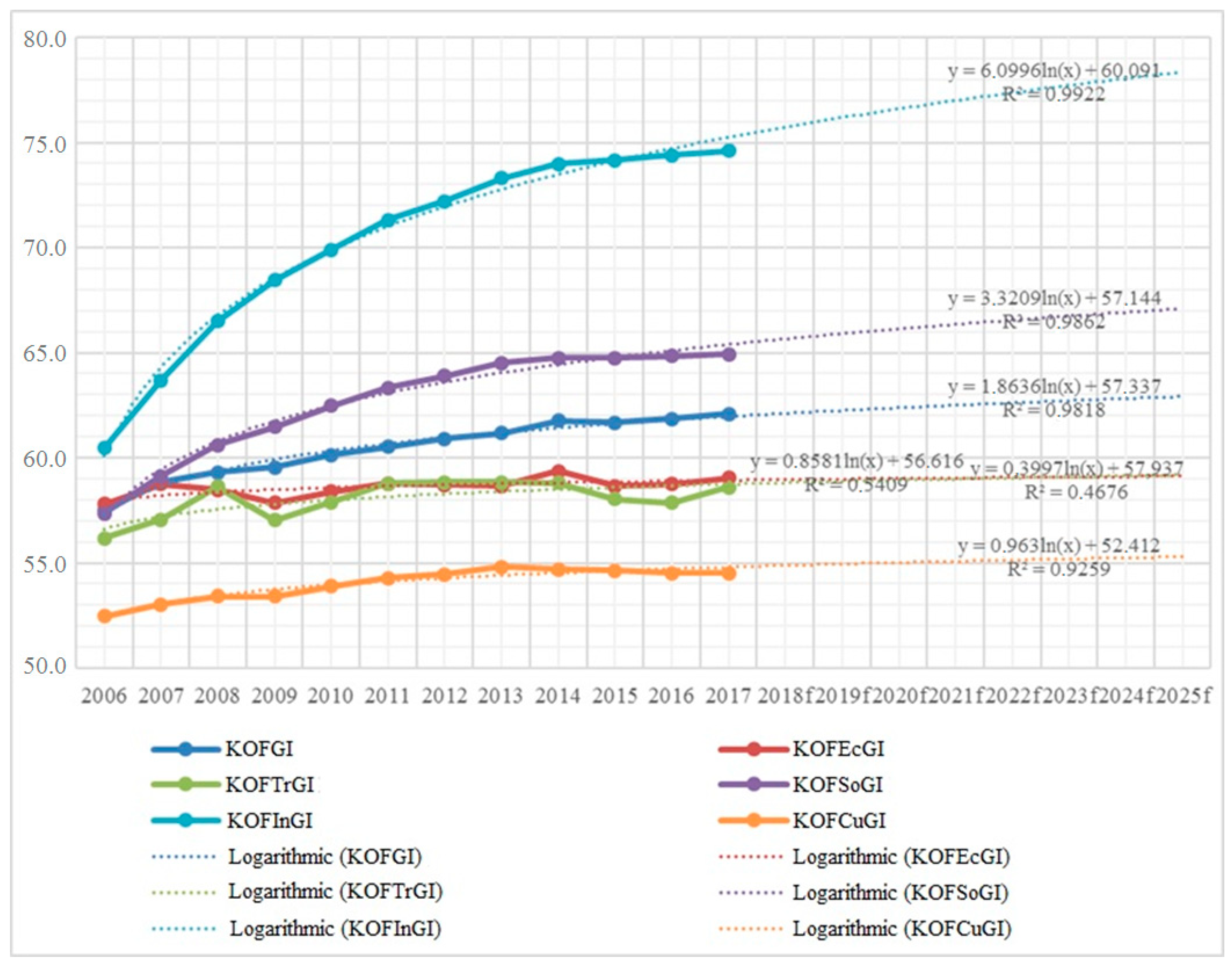
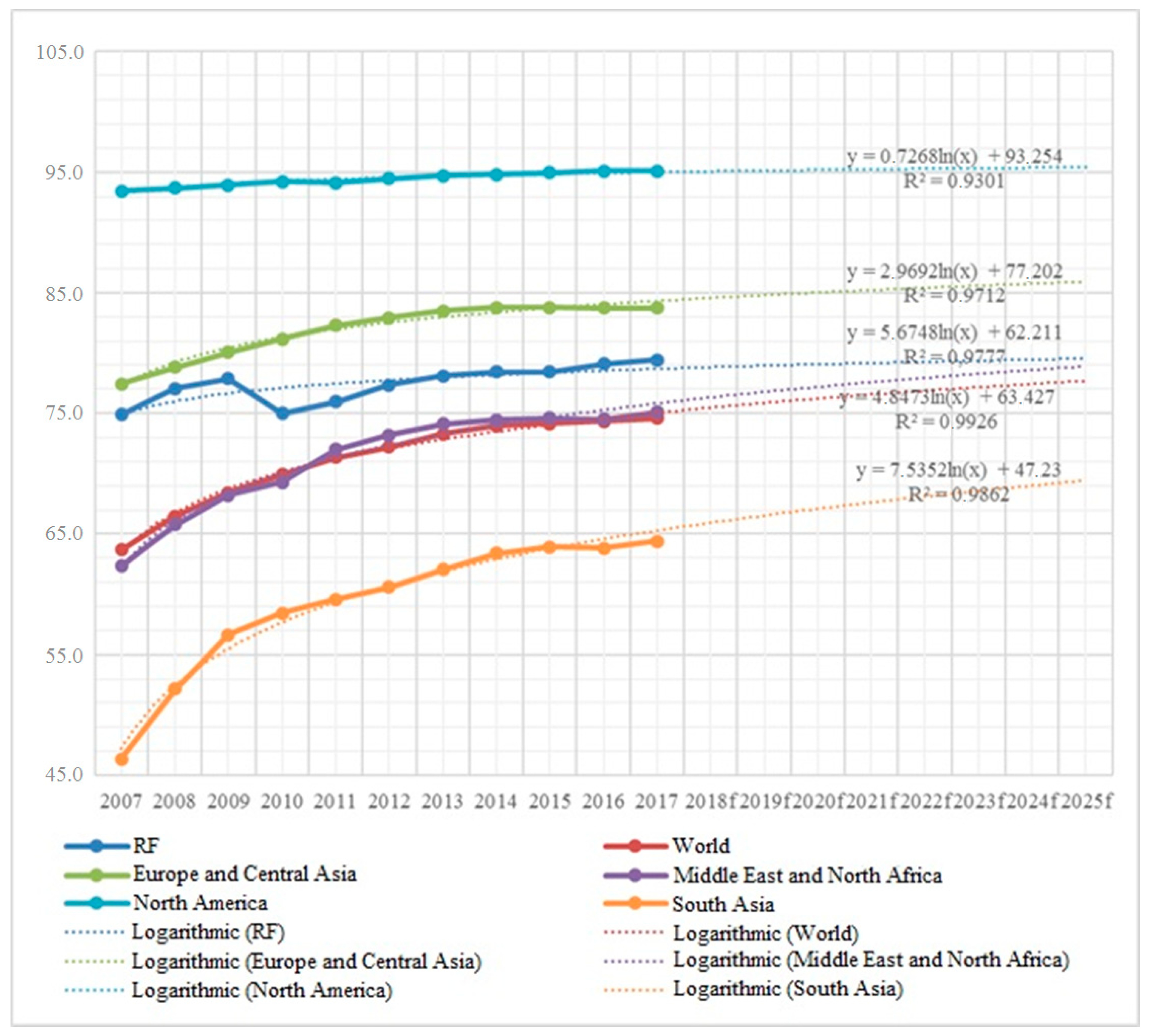
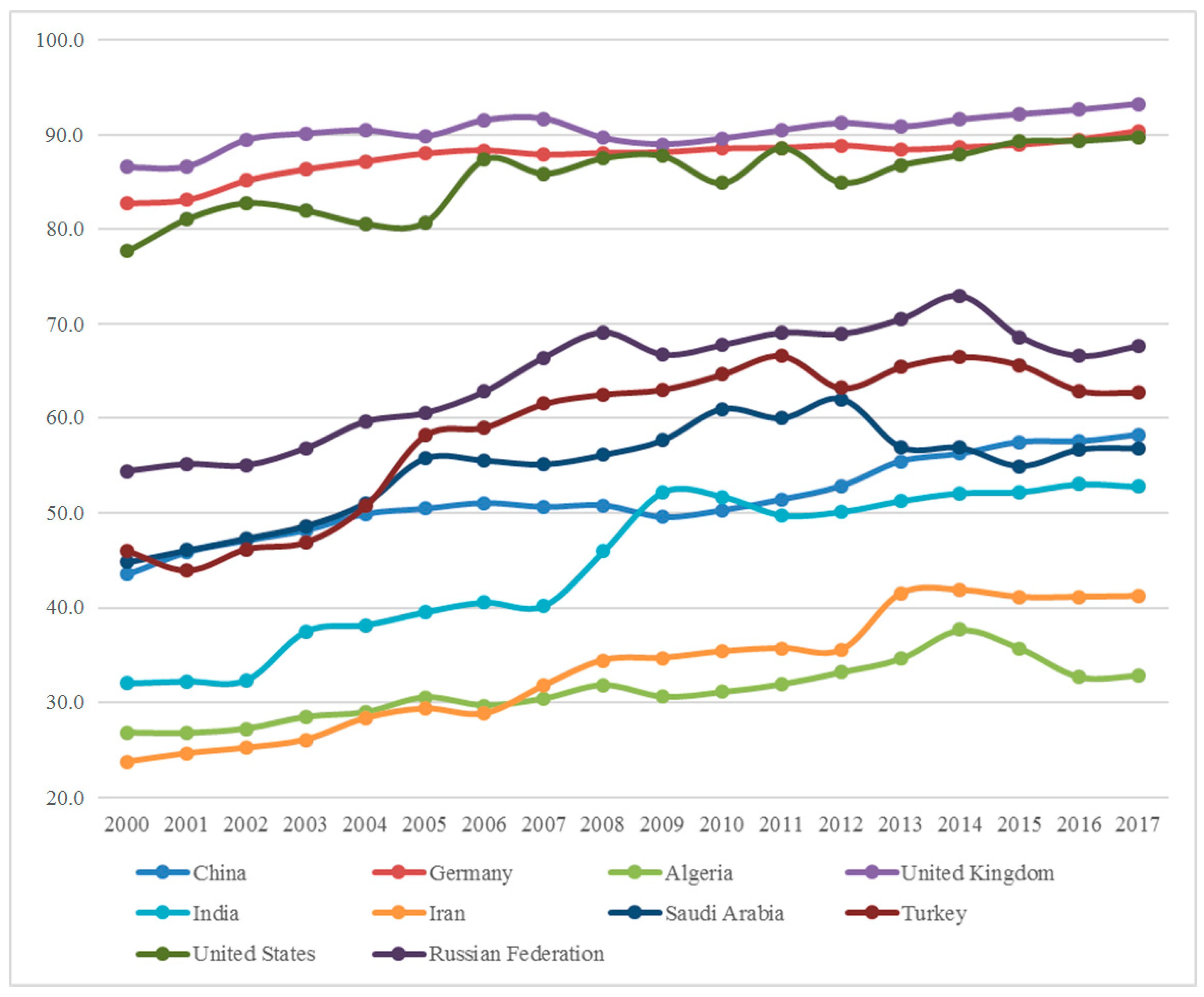
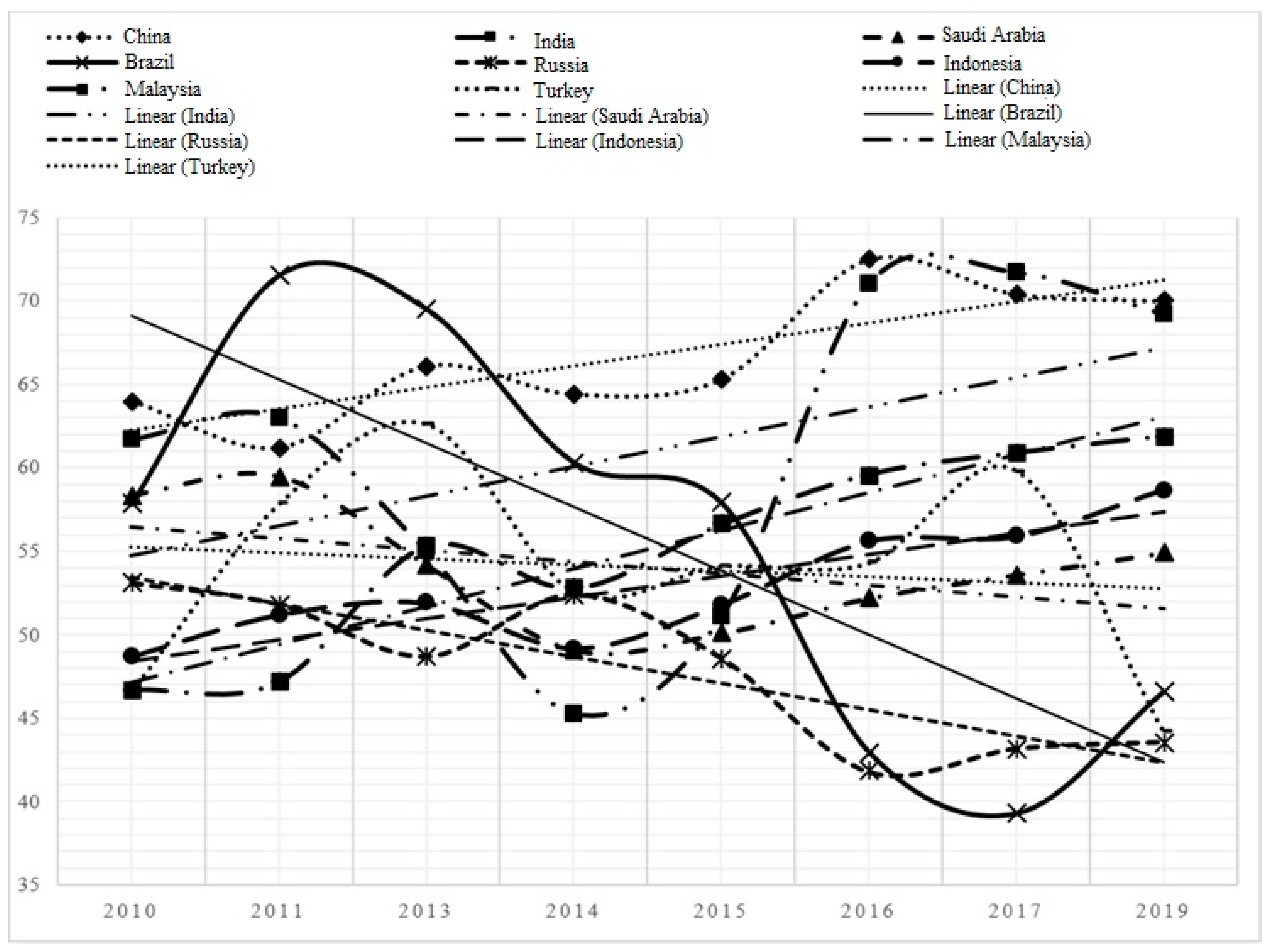
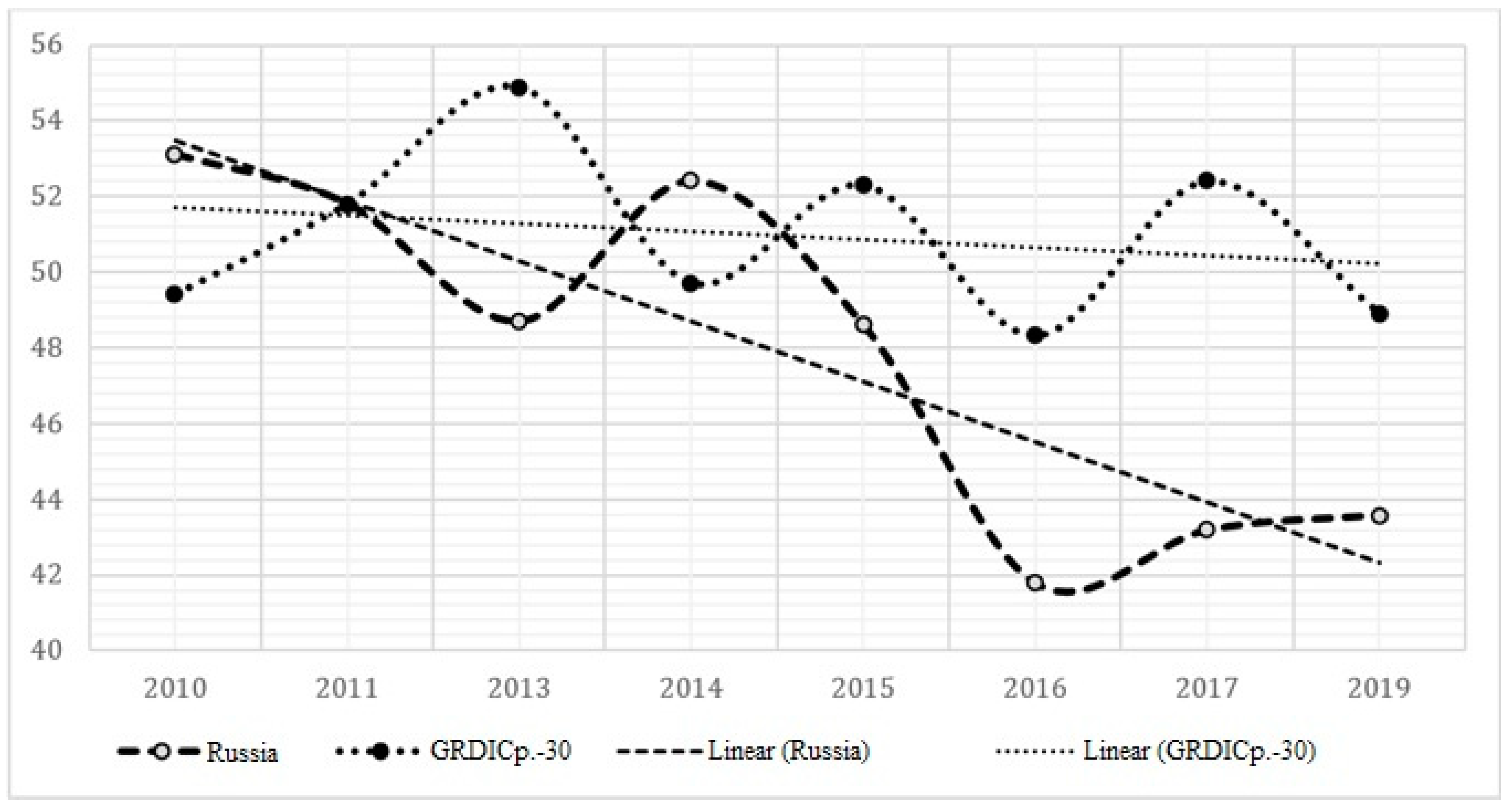
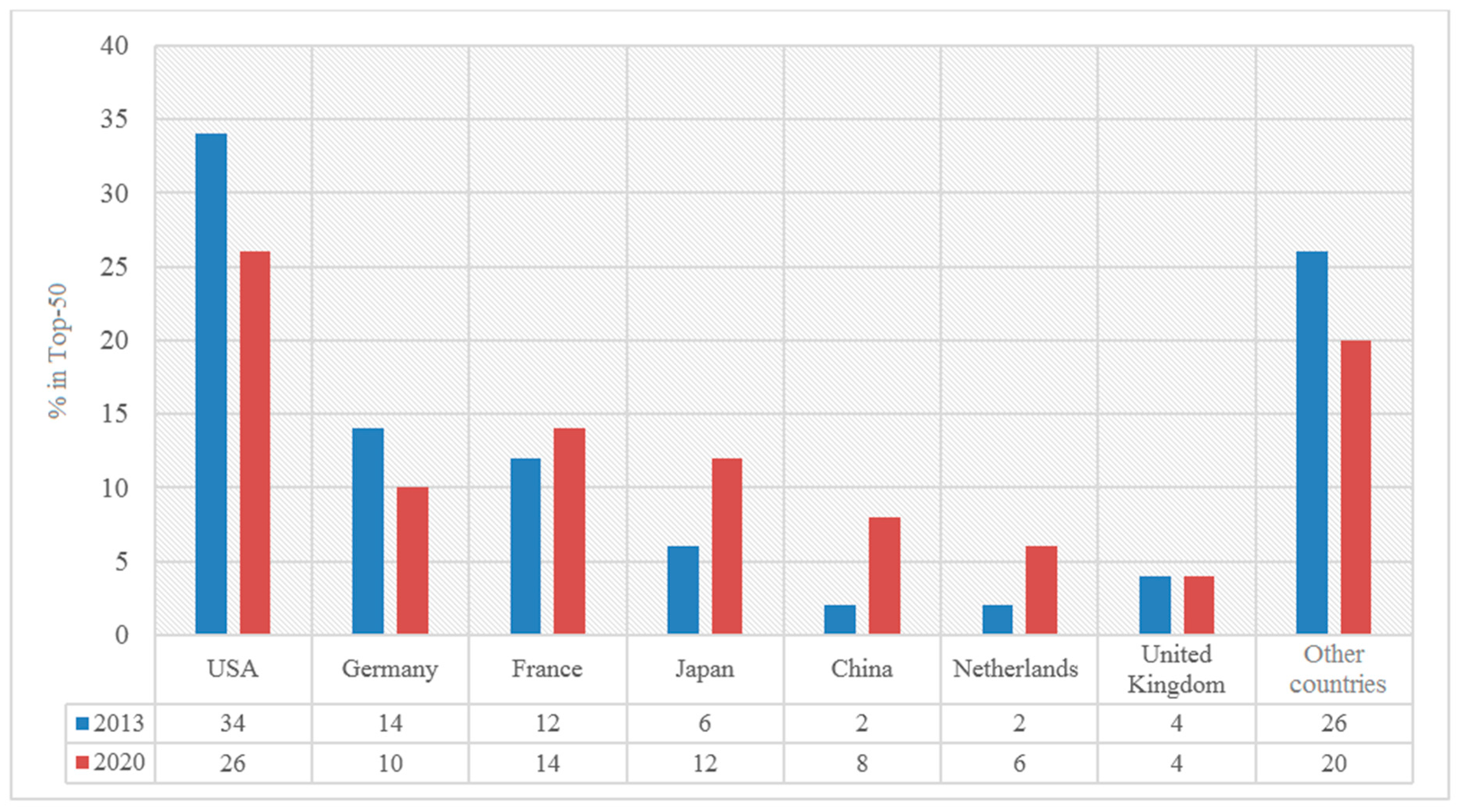
| Indicators and Inputs | KOFGIRF | KOFInGIRF | KOFGIWorld | KOFInGIWorld |
|---|---|---|---|---|
| 1. Average per capita disposable household resources in the Russian Federation, rubles per month | 0.920 | 0.988 | 0.994 | 0.992 |
| 2. Share of population with average money income below the threshold set based on the actual money income levels (per capita, median and modal), % | −0.784 | −0.866 | −0.784 | −0.965 |
| 3. Employment in the age bracket between 15 and 72 | 0.830 | 0.961 | 0.936 | 0.961 |
| 4. Unemployment in the age bracket between 15 and 72 (based on sampling surveys of the labour force), thousand people | −0.659 | −0.897 | −0.847 | −0.880 |
| 5. Labour productivity indices in the Russian economy | −0.715 | −0.636 | −0.713 | −0.726 |
| 6. Growth of high productivity jobs in the Russian Federation, % | −0.631 | −0.399 | −0.511 | −0.639 |
| 7. Share of population using the Internet to order goods and (or) services as a percentage of the total population, % | 0.762 | 0.971 | 0.860 | 0.880 |
| 8. Environmental spending in the Russian Federation (in actual prices, million rubles) | 0.911 | 0.943 | 0.978 | 0.946 |
| 9. Outbound tourism, thousands | −0.720 | −0.068 | 0.181 | −0.321 |
| 10. Migration activity | 0.808 | 0.952 | 0.917 | 0.961 |
| 11. Per capita volume of paid cultural services, rubles | 0.955 | 0.945 | 0.960 | 0.935 |
| 12. Per capita volume of paid healthcare services, million rubles | 0.835 | 0.998 | 0.998 | 0.998 |
| 13. Volume of tourism services, million rubles | 0.948 | 0.974 | 0.974 | 0.984 |
| 14. Share of products compliant with quality and safety standards, % | 0.832 | 0.951 | 0.853 | 0.947 |
| 15. Relative weight of retail chains in the retail turnover of food products, % | 0.946 | 0.920 | 0.937 | 0.903 |
| KOFGI | KOFEcGI | KOFTrGI | KOFSoGI | KOFInGI | KOFCuGI | |
|---|---|---|---|---|---|---|
| East Asia and Pacific | 1.46 | 1.32 | 1.31 | 1.50 | 1.97 | 1.20 |
| Europe and Central Asia | 1.27 | 1.30 | 1.36 | 1.19 | 1.33 | 1.07 |
| Latin America and Caribbean | 1.39 | 1.34 | 1.43 | 1.42 | 1.76 | 1.17 |
| Middle East and North Africa | 1.41 | 1.22 | 1.25 | 1.54 | 1.87 | 1.47 |
| North America | 1.16 | 1.21 | 1.13 | 1.13 | 1.21 | 1.02 |
| South Asia | 1.65 | 1.31 | 1.37 | 2.45 | 3.31 | 1.82 |
| Sub-Saharan Africa | 1.50 | 1.20 | 1.20 | 1.84 | 2.59 | 1.39 |
| KOFGI | KOFEcGI | KOFTrGI | KOFSoGI | KOFInGI | KOFCuGI | |
|---|---|---|---|---|---|---|
| World-2008/1997 | 1.20 | 1.16 | 1.19 | 1.26 | 1.40 | 1.14 |
| World-2017/2008 | 1.05 | 1.01 | 1.00 | 1.07 | 1.12 | 1.02 |
| East Asia and Pacific-2008/1997 | 1.18 | 1.14 | 1.15 | 1.22 | 1.39 | 1.10 |
| East Asia and Pacific-2017/2008 | 1.08 | 1.04 | 1.02 | 1.08 | 1.11 | 1.03 |
| Europe and Central Asia-2008/1997 | 1.18 | 1.16 | 1.14 | 1.19 | 1.27 | 1.12 |
| Europe and Central Asia-2017/2008 | 1.03 | 1.03 | 1.06 | 1.04 | 1.06 | 1.02 |
| Latin America and Caribbean-2008/1997 | 1.18 | 1.21 | 1.34 | 1.22 | 1.35 | 1.07 |
| Latin America and Caribbean-2017/2008 | 1.03 | 0.99 | 0.97 | 1.04 | 1.08 | 0.99 |
| Middle East and North Africa-2008/1997 | 1.24 | 1.20 | 1.27 | 1.30 | 1.48 | 1.21 |
| Middle East and North Africa-2017/2008 | 1.02 | 0.95 | 0.93 | 1.08 | 1.14 | 1.06 |
| North America-2008/1997 | 1.05 | 1.03 | 0.99 | 1.09 | 1.13 | 1.05 |
| North America-2017/2008 | 1.01 | 1.04 | 1.04 | 1.00 | 1.01 | 0.96 |
| South Asia-2008/1997 | 1.33 | 1.21 | 1.26 | 1.81 | 2.02 | 1.68 |
| South Asia-2017/2008 | 1.07 | 0.95 | 0.95 | 1.17 | 1.23 | 1.06 |
| Sub-Saharan Africa-2008/1997 | 1.25 | 1.09 | 1.16 | 1.48 | 1.77 | 1.23 |
| Sub-Saharan Africa-2017/2008 | 1.07 | 1.02 | 0.96 | 1.15 | 1.28 | 1.02 |
| Country | KOFGI | KOFInGI | KOFCuGI |
|---|---|---|---|
| Brazil | 1.2 | 1.5 | 1.3 |
| China | 1.2 | 1.8 | 1.3 |
| Germany | 1.0 | 1.1 | 1.1 |
| Algeria | 1.2 | 2.3 | 1.2 |
| France | 1.0 | 1.2 | 1.1 |
| United Kingdom | 1.0 | 1.1 | 1.1 |
| India | 1.3 | 2.0 | 1.6 |
| Iran | 1.4 | 2.4 | 1.7 |
| Japan | 1.2 | 1.2 | 1.2 |
| Saudi Arabia | 1.2 | 1.7 | 1.3 |
| Turkey | 1.1 | 1.3 | 1.4 |
| United States | 1.1 | 1.2 | 1.2 |
| World | 1.2 | 1.4 | 1.1 |
Publisher’s Note: MDPI stays neutral with regard to jurisdictional claims in published maps and institutional affiliations. |
© 2021 by the authors. Licensee MDPI, Basel, Switzerland. This article is an open access article distributed under the terms and conditions of the Creative Commons Attribution (CC BY) license (http://creativecommons.org/licenses/by/4.0/).
Share and Cite
Ramazanov, I.A.; Panasenko, S.V.; Cheglov, V.P.; Krasil’nikova, E.A.; Nikishin, A.F. Retail Transformation under the Influence of Digitalisation and Technology Development in the Context of Globalisation. J. Open Innov. Technol. Mark. Complex. 2021, 7, 49. https://doi.org/10.3390/joitmc7010049
Ramazanov IA, Panasenko SV, Cheglov VP, Krasil’nikova EA, Nikishin AF. Retail Transformation under the Influence of Digitalisation and Technology Development in the Context of Globalisation. Journal of Open Innovation: Technology, Market, and Complexity. 2021; 7(1):49. https://doi.org/10.3390/joitmc7010049
Chicago/Turabian StyleRamazanov, Ibragim Agaevich, Svetlana Viktorovna Panasenko, Vyacheslav Petrovich Cheglov, Elena Anatol’evna Krasil’nikova, and Alexander Fedorovich Nikishin. 2021. "Retail Transformation under the Influence of Digitalisation and Technology Development in the Context of Globalisation" Journal of Open Innovation: Technology, Market, and Complexity 7, no. 1: 49. https://doi.org/10.3390/joitmc7010049
APA StyleRamazanov, I. A., Panasenko, S. V., Cheglov, V. P., Krasil’nikova, E. A., & Nikishin, A. F. (2021). Retail Transformation under the Influence of Digitalisation and Technology Development in the Context of Globalisation. Journal of Open Innovation: Technology, Market, and Complexity, 7(1), 49. https://doi.org/10.3390/joitmc7010049




